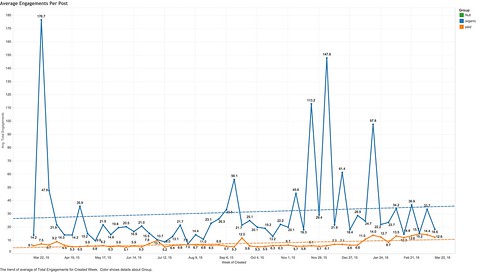Olivier Blanchard started a conversation yesterday on Facebook by positing that professional influencers may not move the needle for the brands that hire them, if we vet influencers only on audience reach/follower counts. He asked what the performance differences might be if we judged influencers on things like engagements or down funnel metrics like link clicks. Is there a difference? Is paying a ‘professional’ influencer worthwhile?
Using the advanced research facilities at SHIFT Communications, I took him up on the challenge. We pulled a list of 16 influencers on Twitter in the business and technology sector. 8 of them are brand-side influencers who generally do not accept money to promote content, other than from their employer. 8 of them are professional influencers who accept significant sponsorships above and beyond their employers, celebrities of sorts. Olivier provided the lists and classifications.
Let’s first look at the distribution of audience reach:
Our influence pool has an average following of 140,000 and a median following of 98,000. We see a reasonable distribution of unpaid (organic, in blue) and paid (in orange) influencers in our pool.
Let’s move beyond raw audience numbers to engagement. How much engagement do organic and paid influencers generate? We define engagement as the sum total of actions a person can take on an influencer’s status; on Twitter, that’s replies, likes (formerly Favorites), and retweets. We looked at the last year of data for these influencers and charted it out:
What we see is a sizable difference in overall engagement levels; organic influencers generate up to 6x the engagement of paid influencers. Why? Part of the reason is volume of content. More content isn’t necessarily better; paid influencers generate significantly more content:
Above, paid influencers generated a median of 10,050 posts per quarter; unpaid influencers generated an average of 1,770.
How impactful are influencers at engaging their audiences? We measured engagements divided by total audience size:
What we see above is neither organic nor paid influencers are especially good at engaging a significant portion of their audience. Organic influencers engage 0.015% – that’s 1.5 out of every 10,000 people – while paid influencers engage 1 out of every 10,000 people who follow them. Organic influencers do slightly better, but not by a significant margin.
Let’s talk about where the rubber meets the road: clicks and audience shares. For the links influencers share, how many shares do those links get from the overall audience? How many clicks do influencers generate? Here’s where the stark difference lies:
We see that links shared by organic influencers garner significantly more shares and clicks than links shared by paid influencers. Why such a difference? Most of what organic influencers share is news, content audiences are likely to share anyway. Because paid influencers generate so much more volume (due to promotion of sponsorships, etc.) we would expect their performance to be significantly lower. I invite you to download the anonymized raw data here.
What does all this data tell us? Be very careful how you vet influencers. The biggest megaphone in the room doesn’t necessarily mean spurring action we want as marketers. Take into account reach, of course. Take into account other factors, such as engagement, topical alignment, what else the influencer shares, and whether they generate any real action down the marketing funnel.
You might also enjoy:
- Almost Timely News, January 28, 2024: Copyright Must NEVER Apply to AI-Made Works
- Mind Readings: Generative AI and Addition vs Substitution of Jobs
- Almost Timely News, January 7, 2024: Should You Buy a Custom GPT?
- You Ask, I Answer: Legality of Works in Custom GPTs?
- Almost Timely News, January 14, 2024: The Future of Generative AI is Open
Want to read more like this from Christopher Penn? Get updates here:
 Take my Generative AI for Marketers course! |







Leave a Reply